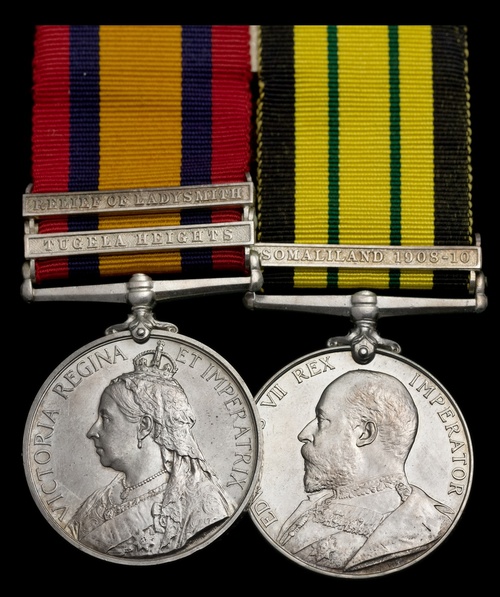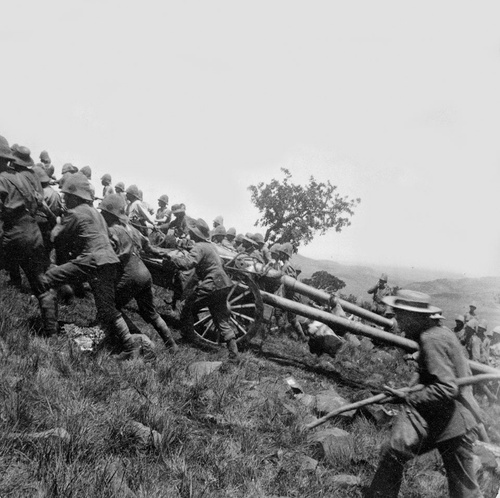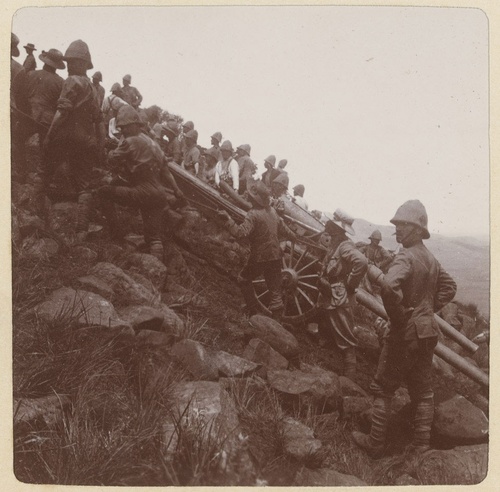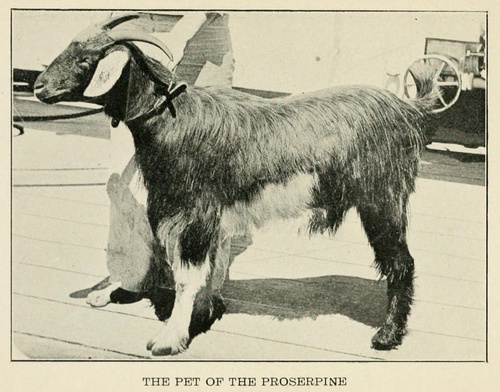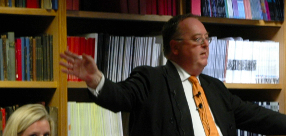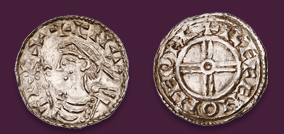Auction: 24113 - Orders, Decorations and Medals - e-Auction
Lot: 407
'These men behaved with great gallantry and, turning up their coat-collars as if the pattering round them was only a rain shower, worked their teams with great coolness.'
So it was reported how Lieutenant James and his Bluejackets performed under fire at Colenso
The campaign pair awarded to Captain H. W. James, Royal Navy, who, as Lieutenant of Tartar was in command of a battery of guns at the Battle of Colenso, was mentioned in Buller’s despatch and specially promoted to Commander for services during the war; he commanded Proserpine in the Somaliland operations of 1908-10
Queen’s South Africa 1899-1902, 2 clasps, Tugela Heights, Relief of Ladysmith (Lieut: H. W. James, R.N. H:M:S: Tartar) officially impressed naming; Africa General Service 1902-56, 1 clasp, Somaliland 1908-10 (Commr. H. W. James, R.N. H.M.S. Proserpine.), extremely fine (2)
Herbert William James was born on 3 April 1871 at Cransley, near Kettering, Northamptonshire, and entered the service aboard the Training Ship Britannia on 15 July 1884. On passing out of Britannia he obtained two 2nd Class and four 3rd Class Certificates, thus gaining seven month's seniority. He joined H.M.S. Iron Duke (July 1886) and was promoted to Midshipman on 15 December 1886, next serving aboard Audacious (November 1887), Imperieuse (February 1888), Rodney (July 1889), Monarch (November 1889), and Impregnable (March 1890). Whilst on his Pilotage Course in the latter ship he was promoted to Acting Sub Lieutenant on 14 December 1890 and was confirmed in this rank six months later with the same seniority date. He next served aboard Superb (July 1891), Ruby (April 1892) being promoted to Lieutenant on 1 April 1893, Latona (July 1893), Centurion (February 1894), Colossus (June 1897), Inflexible (August 1897), Trafalgar (October 1897) and Tartar (May 1898).
Whilst in Tartar he was appointed 1st Lieutenant and landed with the ship’s Naval Brigade for service in South Africa, where he Commanded a Battery of Guns. At the Battle of Colenso he had command of two Naval 12 -pounders, and continued with his Battery throughout the operations which culminated in the Relief of Ladysmith. James was specially promoted to Commander on 21 October 1900 for services rendered during the war in South Africa. He is variously mentioned for his fine services, most notably in Lieutenant Ogilvy's Official Report for the actions at Colenso:
'Acting on orders received from Captain Jones, R.N., I reported myself to Colonel Long, C.R.A., who directed me to attach myself to him until the guns had been placed in a suitable position. I therefore directed Lieutenant James of Tartar, to lead the Battery behind the Royal Artillery field guns, and told him that we were to form up on the left of the Royal Artillery guns when they came into action. About 6 a.m., the guns being in column of route march with Naval guns in the rear, I was riding in front with Colonel Long about 450 yards from Colenso station, when he directed Colonel Hunt to bring his guns into action just in front of a deep donga running across our front at right angles to the railway. He then told me to come into action on the left, and proceeded to arrange our different zones of fire, while the Royal Artillery guns were getting into position. In front of us was a line of trees up to which our skirmishers had advanced, also a few artillery outposts. Just as I was about to direct my guns where to go, and as the Royal Artillery were unlimbering, the outposts turned sharply and a murderous fire, both rifle and shell, was opened on the guns and ammunition column. I immediately galloped back to my guns and found that the fire had caught them just as the two centre guns were going through a drift across another donga parallel to the before-mentioned one, but about 400 yards in the rear.
When I arrived I found that all the native riders with the exception of those for Lieutenant James's gun teams had bolted. These guns had just crossed the drift, so I directed him to take up a position on the left and opened fire on Fort Wylie, from which the majority of the shell fire appeared to come. About this time my horse was shot through the shoulder by a rifle bullet. The two rear guns under Lieutenant Deas of H.M.S. Philomel, not having crossed the drift, I directed him to take ground on the left and open fire also on Fort Wylie. The two centre guns under Mr. Wright, gunner of H.M.S. Terrible, were unfortunately jammed with their ammunition waggons in the drift, the wheels of the waggons being locked and the oxen turned round in their yokes. I managed by the aid of some artillery horses to extricate these guns from the drift and to bring them into action on each side of the drift to the rear of the donga, one of the horses being shot while doing this. I could not manage to move the ammunition waggons, as the rifle and shell fire was too severe at the time, a Maxim-Nordenfeldt being particularly attentive, and sending three shells into the drift at every discharge.
Repeated messages for more men came back from the Royal Artillery batteries, and these were sent to the front by a Royal Artillery sergeant in charge of the ammunition column. After about half an hour's firing, as I should judge, the Royal Artillery guns were silenced, nearly all the men being apparently killed or wounded. Soon after this the fire from Fort Wylie slackened considerably. The Commander-in-Chief now rode up and directed me to move our guns and ammunition as soon as I could. The guns were got away each by a team of artillery horses, who galloped them up the hill to the rear. The waggons were far more difficult, owing to their weight, the large circle they required to turn in, and to the fact that they had to be got out from the drift and turned round by the guns' crews before the horses could be put on.
About this time a most brilliant feat was performed by two teams of artillery, who galloped to the front, against a most murderous fire, limbered up, and rescued two guns; a similar attempt by one other team, at least, resulted in the entire team, as far as I could see, being destroyed. The advance of the Infantry on an open plain, with little or no cover against a most heavy rifle fire from entrenched positions was also a magnificent sight. The conduct of our men without exception was particularly fine, the day being a very hot one and the work hard. The way Nos. 1 and 2 guns' crews of the Terrible got their waggons out of the drift under heavy fire from shell and rifle was quite up to the standard expected of all seamen.
I cannot conclude without mentioning the way Lieutenant James of the Tartar selected the best suitable position and opened fire with great effect. Lieutenant Deas, of the Philomel, unfortunately had a gun capsized as they were moving off to the left to come into action, but managed to mount it quickly and brought both guns into action. After the first few minutes these two officers took entire charge of their respective guns, and brought them safely out of action; Lieutenant James coming again into action on the left under the direction of Captain Jones.'
In the rank of Commander he served aboard Victory (February 1901) for Signal Course, Excellent and Vernon (March 1901) for Gunnery & Torpedo Courses, Albion (June 1901), and President (November 1902) for Senior Officer's Course at Greenwich Naval College. He was next appointed to the command of Satellite (October 1903) and Proserpine (August 1906) which ship he commanded during the operations in Somaliland - they were not short of action and suffered three killed in action in April 1908, against the pirates and gun-runners off the coasts of Africa. James would also have become acquainted with her famous mascot, that being a prized goat.
He commanded Renown (November 1908) and Crescent (July 1909) and retired at own request due to failing health on 17 June 1910, with the rank of Captain. He died on 19 April 1911.
Captain (later Brigadier-General) F. R. Patch, Royal Artillery, captured numerous striking images of the Naval Guns in the Boer War.
Subject to 20% VAT on Buyer’s Premium. For more information please view Terms and Conditions for Buyers.
Sold for
£2,400
Starting price
£1200

